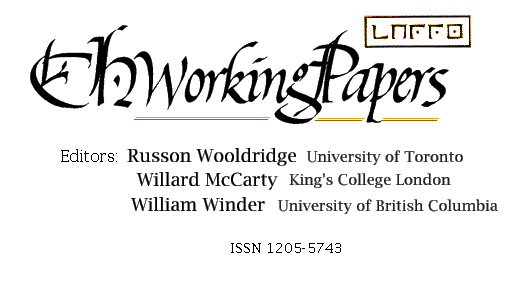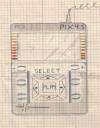
I just noticed that the CH Working Papers have a new look and structure. They are using the Public Knowledge Project Open Journal Systems to good effect. I’m impressed how they have ported over the legacy content like the article I co-authored with John Bradley on Eye-ConTact: Towards a New Design for Text-Analysis Tools. The only wrinkle is the first letter of the authors’ names in the bibliography and small subheadings.
AHRC ICT Methods Network: Final Report
I just came across the AHRC ICT Methods Network Final Report edited by Lorna Hughes. It is one of the most thorough final reports of its kind and nicely designed. There is a bitter-sweet conclusion to the report by Susan Hockey and Seamus Ross as the AHDS (Arts and Humanities Data Service) seems to have had its funding cut and therefore cannot renew the Methods Network (or support the Oxford Text Archive either.) As the home page of the AHDS says, “From April 2008 the Arts and Humanities Data Service (AHDS) will no longer be funded to provide a national service.” The conclusion by Susan and Seamus states unequivocally that,
In conclusion, the activities of the Methods Network demonstrated not only that ICT methods and tools are central to humanities scholarship, but also that there was ‘a very long way to go before ICT in humanities and arts research finds its rightful and needed places’. The investment in ICT in the arts and humanities needs to be much greater and it needs to reflect better the particularities and needs of individual communities. Researchers who do not have access to the most current technological methods and tools will not be able to keep
pace with the trends in scholarship. There is a real need for support and infrastructure for distributed research. (page 74)
Interestingly they propose a “flexible co-ordinated network of centres of excellence as the best way forwards”. (Page 74) I also liked the report because it kindly mentions TAPoR,
The group looked at how collaborations are fostered and supported, how partnerships are brokered in the first instance, and how this work is rewarded and evaluated by the different communities. Geoffrey Rockwell, Project Director of what is almost certainly the largest collaborative humanities software development project in the world, the TAPoR (http://portal.tapor.ca/portal/portal) project in Canada, shared his experiences of how the development of a collaborative and inter-institutional set of tools for text analysis was managed within the project. TAPoR was funded by the Canada Foundation for Innovation and succeeded in its overall goals in providing general purpose text analysis tools. The TAPoR site reports that its tools were run over 5000 times in November 2007. TAPoR provides strong evidence that networked collaborative tool development can succeed. (Page 63)
ThoughtMesh: Tag your writing. Join the conversation.
 Matt sent around a link to ThoughtMesh, an original idea about how tag-rich online publishing might work. You can get an account and upload an essay (it encourages you to divide into chunks) or self-publish so your essay is meshed. I’m not entirely sure how it works, but it gives you contextual tag clouds to use to see related stuff.
Matt sent around a link to ThoughtMesh, an original idea about how tag-rich online publishing might work. You can get an account and upload an essay (it encourages you to divide into chunks) or self-publish so your essay is meshed. I’m not entirely sure how it works, but it gives you contextual tag clouds to use to see related stuff.
Here is what Jon Ippolito says in his essay, ThoughtMesh Author’s Statement,
When Craig Dietrich and I set out to build ThoughtMesh, we asked ourselves how an ideal publishing tool for scholars would behave. We decided that we wanted a system that was distributed–not siloed away in a single database, but able to be published on any Web site anywhere. We also wanted all the essays to be connected to each other, by something less random than search returns, but more serendipitous than intentional hyperlinks.
A Brief History of Neon — New York Magazine

In A Brief History of Neon in New York Magazine I came across reference to Artkraft Strauss one of the first and most important makers of neon signs, ads and marquees. Artkraft Strauss dominated the design of neon signs for Times Square including the new year’s midnight ball-lowering. Artkraft Strauss is still around as a design and consulting company and they have a great archive of images of “100 years of commerce, design and Times Square celebrations”. It is a treasure of neon sign design in New York from the first days.
TheStar.com | Federal Election | Web outrage marks shift in Canadian politics
Alex Sévingy drew my attention to an article by Linda Diebel for the Toronto Star, Web outrage marks shift in Canadian politics (Sept. 12, 2008) that argues that Green leader Elizabeth May owes here inclusion in the upcoming debates to rapid voter reaction over the Internet.
Suddenly, in a very public way, ordinary citizens were empowered through their blogs, vlogs (videos) and online comment to the mainstream media, and they got what they wanted.
Alex himself is quoted in the article suggesting that it was Stephane Dion who broke the impasse.
“For the first time in Canadian election history, a grassroots activism influenced a leader to take a stand against the others,” he said. “As a result, the traditional media regulators had to concede that the populist approach was right.”
Adds Sévigny: “An authority figure opened the door. But, in my view, this is one of the last times the blogosphere needs validation of someone in authority.”
Given how short Canadian elections are one wonders if the speed of the Internet is the only way for voters to participate in the process, rather than just the vote.
Essay: His Rock Is His Thing
Camus, at the end of “The Myth of Sisyphus” writes, “His rock is his thing.”. This got me thinking about play, interactivity and this age. So I wrote a short essay on Playing with the Myth of Sisyphus, One Interactive Button, and the Flicker of the Baroque. Seriously, my rock is my thing.
High Performance Computing in the Arts & Humanities
Last April I helped organize a workshop on how High Performance Computing centres like SHARCNET can support the humanities. One of the things we agreed was needed was a good introduction to the intersection. John Bonnet agreed to write one and Kyle Kuchmey worked with me on examples to produce High Performance Computing in the Arts & Humanities. We hope this will be a gentle introduction to the intersection.
Kane Kramer: Inventor of the Digital Audio Player?
 I came across a story that Kane Kramer, and English inventor, invented the digital audio player and patented it in 1979 though he lost the patent. Here is an interview with the Guardian.
I came across a story that Kane Kramer, and English inventor, invented the digital audio player and patented it in 1979 though he lost the patent. Here is an interview with the Guardian.
No. I like the iPod, but it feels a bit unfair to have to buy one. I could show you my drawings from 1979-82 and there is an iPod – same size, shape. It feels like mine.
Kane apparently testified for Apple when they were being sued by others.
The World of Dante
 The World of Dante is a totally renovated site from the University of Virginia (IATH) on Dante. It has some neat features. They use an image by Domenico di Michelino of Dante Reading from the Divine Comedy as a visual introduction to the site. You roll over the parts of the image and get an introduction to the project. The project also has a lot of media, including music that was commissioned to connect to references in the text to music. I heard some of this music at the New Horizons conference. This is a gem of a project even if sometimes paging the texts is slow – I’m told that it has to do with caching – just be patient.
The World of Dante is a totally renovated site from the University of Virginia (IATH) on Dante. It has some neat features. They use an image by Domenico di Michelino of Dante Reading from the Divine Comedy as a visual introduction to the site. You roll over the parts of the image and get an introduction to the project. The project also has a lot of media, including music that was commissioned to connect to references in the text to music. I heard some of this music at the New Horizons conference. This is a gem of a project even if sometimes paging the texts is slow – I’m told that it has to do with caching – just be patient.
Pushing Play
 A student of mine from last year, Jacob, who was one of the two who did the innovative Half-Life Havoc project, has started a gaming blog and company, Pushing Play. His company is developing game conference,
A student of mine from last year, Jacob, who was one of the two who did the innovative Half-Life Havoc project, has started a gaming blog and company, Pushing Play. His company is developing game conference,
The Pushing Play Conference is all about bringing hardcore, casual, midcore gamers together, as well as Ludologists, game designers, and even non-gamers. By bringing these people together and giving them a forum to interact we can get a better understanding of the gaming community as a whole, rather than supporting the over-used image of gamers strictly being teenage boys.